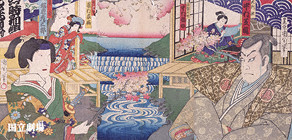Summary
“Imoseyama Onna Teikin” is a gidayu-kyogen of jidai-mono [Ocho-mono/Odai-mono: tales of royalty/tales of the imperial era] describing the activities of Fujiwara no Kamatari, his son Tankai, and their party, who are attempting to overthrow the rebel Soga no Iruka who has sworn to take over the imperial throne.
The following scenes are most commonly performed in this play: ‘Yoshinogawa’ (Yoshinogawa River) scene portrays the tragic story of Koganosuke and Hinadori, who love each other but perish due to tyranny of Iruka; and ‘Michiyuki Koi no Odamaki’ (Michiyuki Travel Scene : The Spools of Love), stylized dance scene depicting a love triangle between a princess named Tachibanahime, and Omiwa, daughter of sake shop owner, who both fall in love with the same man, Motome. The ‘Mikasayama Goten’ (Mikasayama Palace) scene in which Omiwa is sacrificed to get rid of Iruka.

“Imoseyama Onna Teikin” ‘Yoshinogawa’ scene
National Theatre collection (NA050440)
HighlightTwo Sides of the River: A Production Effect in the ‘Yoshinogawa’ Scene
The leading playwright (tatesakusha) of this play was Chikamatsu Hanji (1725-1783), who created the original Ningyo-joruri (Japanese puppet theatre) during the mid-Edo Period. Hanji excelled in jidai-mono, massive stories filled with variety, and left many excellent works behind. His most typical works were converted for Kabuki as gidayu-kyogen, and are still regularly performed.
A common and distinctive feature running through Hanji’s creations is his rendering of contrasts among the characters’ status, personalities, and scene settings. Such distinguishing aspects are revealed vividly in the ‘Yoshinogawa’ scene, in which the mansions of the Dazai and Daihanji families, who are locked in a territorial dispute, appear on either side of the Yoshino River that flows through the center of the stage.
Yet another production effect involves two hanamichi (walkway) stages specially placed to represent the opposite banks of the river. Appearing from the hanamichi on the shimote (stage right) side is Sadaka, the mother of Hinadori, and from the hanamichi on the kamite (stage left) side Daihanji Kiyozumi, father of Koganosuke. Those two characters monologize their hearts from each walkway in a superb staging effect.


